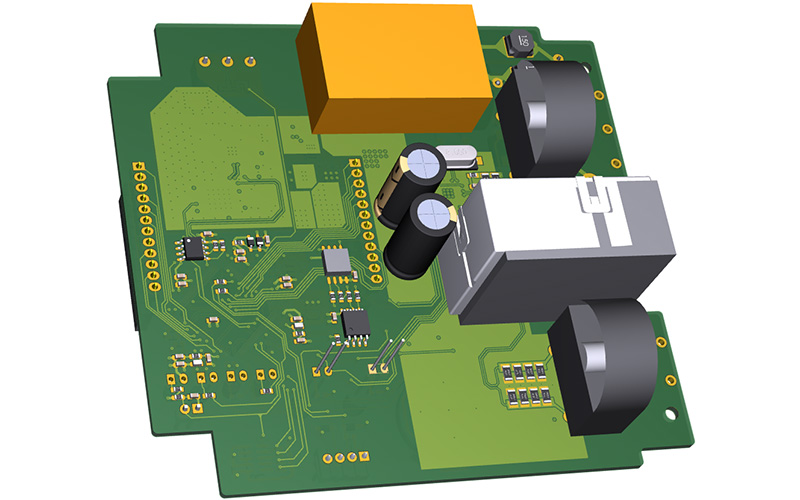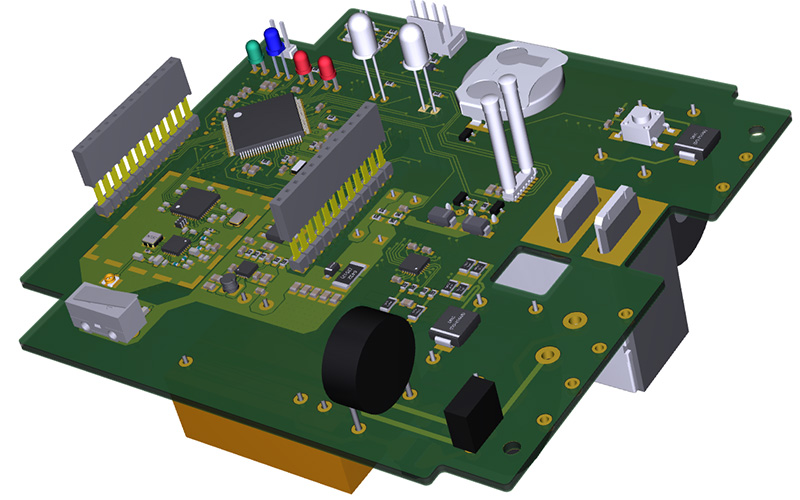-
Mail Us Todaysales@efpcb.com
-
Company LocationShenzhen, Guangdong, China
-
+86-755-23724206Call us for more details



Layer count: 4 layer
Material: FR4 High TG, 1.6 mm, 2 OZ for all layer
Minimum trace: 205 um
Minimum space(gap): 300um
Minimum hole: 0.30mm
Surface finished: LF HASL
Panel size: 220*180mm
Characteristics: FR4 high TG, CTI>=250, Main functions including remote meter reading, remote switching and electricity metering
The Internet of Things (IoT) is not science fiction now, it has been a part of our personal lives and enterprise processes or industry operation. The IoT solutions will reinvent our workplace, home and how we interact with the environment by 2025. Whether it is smart homes and connected healthcare, industrial automation or smart cities, IoT is shaping a more efficient, data-driven, and connected future.
Read on for the latest on industry trends, IoT solution benefits and challenges, and use cases for IoT solutions in 2025 in our in-depth guide. We'll also share ideas on how businesses and people can use IoT to innovate and deliver value in a world where everything is becoming more connected.
IoT solution is a mix of hardware, software and other communication technologies which are used to collect, manage and process this data. These solutions connect devices to other devices as well as to centralized systems, allowing the flow of information to become more simplified and efficient such that it can be used for process automation, increased efficiency, and mature decision making.
IoT applications span a broad spectrum of industries ranging from manufacturing, healthcare, agriculture, transportation to energy. Through the combination of sensors, devices, cloud computing, and powerful analytics, IoT solutions deliver valuable insight to organizations and people to help streamline work, improve operations and reduce the severity of disasters.
Why IoT Solutions Are Essential in 2025
Deployment of IoT solutions is on a fast track, led by technology advances, growing demand for seamless connectivity, greater and easier access to and use of data for analysis and decision making. Following are significant factors behind why IoT is more important than ever in 2025:
Rapid Proliferation of Connected Devices: Statista projects the global IoT devices connected will grow to 30.9 billion by 2025, compared to the 14.2 billion connected in 2021. This explosion in numbers emphasizes the need for strong IoT solutions to handle and make sense of large quantities of data.
5G and Edge Computing The deployment of 5G and progress in edge computing are facilitating faster and more dependable IoT connectivity, thereby opening the door for real-time data processing and low latency applications.
Sustainability Objectives: Optimal energy usage, waste minimization and smart infrastructure development are all contributing to the global drive for sustainability goals – all developments in which IoT solutions are at the forefront.
Consumer expectation: Today’s consumers want experiences that are easy, coherent and personal and that seamlessly link them into today’s digital world —something IoT solutions enable through smart devices and services. Economic impact: McKinsey projects that IoT will have the potential to create between $5.5 trillion and $12.6 trillion in global economic value by 2030, illustrating how transformative the technology could be.
There are several key elements to consider when you add devices to your IoT solution:
1. Devices and Sensors
The building blocks of an IoT solution are IoT devices and sensors. They grab data from the real world around us (temperature, movement, humidity, location, and so on) and send it to the cloud or edge for processing.
2. Connectivity
The Communication is What Holds It All Together At the heart of IoT solutions lies connectivity to ensure devices can communicate with one another and with central systems. It will provide wifi, bluetooth, zigbee, LoRaWAN and cellular (5G) connection possibilities etc.
3. Cloud Computing
Storage and processing are being offered by cloud platforms that are also scalable to handle large amounts of IoT generated data. They also allow for data-driven analytics and machine learning.
4. Edge Computing
Edge computing moves the processing to where the data is, decreasing latency and bandwidth utilization. This is of particular interest in timing critical IoT application such as autonomous vehicle and industrial automation.
5. Data Analytics and AI
Powerful analytics & AI services IoT solutions use advanced analytics and AI to help you unlock new insights from your IoT data. These observations can be utilized to forecast maintenance requirements, to improve operations, and to improve user experiences.
6. User Interfaces
Friendly User’s interfaces, (i.e. mobile applications and dashboards), facilitate end-users to observe and manage IoT devices and to access data, and to receive alerts in a real-time mode.
The adoption of IoT solutions brings several advantages for companies, consumers and the society:
1. Increased productivity and efficiency
THE BENEFITS OF IOT SOLUTIONS Another reason to invest in IoT solutions are the many benefits it can deliver. In manufacturing, practitioners can even see downtime fall by up to 50 percent via IoT-enabled predictive maintenance, Deloitte noted.
2. Enhanced Decision-Making
IoT solutions help empower businesses to take decisions by providing the real-time data, and actionable insights. For example, retailers can access IoT data to manage inventory more efficiently and enhance customer experiences.
3. Cost Savings
Energy Efficiency, Waste Reduction, And Equipment Failure Prevention IoT solutions also create cost savings through reductions in energy usage and waste generation, as well as predictive maintenance. According to a study by PWC, IoT based energy management systems can save more than 25% in energy costs.
4. Better Customer Experiences
IoT solutions provide personalized and connected experiences, for consumers. Smart home appliances, for instance, can remotely control equipment such as lights, heating and security systems, leading to improved convenience and comfort.
5. Sustainability
There are also solutions to support sustainable objectives quite well, such as IoT solutions that support the smart grids for energy, precision agriculture and efficient waste management. The IoT can potentially cut global greenhouse gas emissions by 15% by 2030, the World Economic Forum reports.
These IoT services are great benefits for both people and enterprises, but there are challenges to be met with, to release the full power of IoT services:
1. Security and Privacy
IoT device data transfer and IoT devices produce a massive amount of data which to consider a lot of), it raises some serious security and privacy concerns. Cyber attacked security breaches, and improper access are a huge problem from both a business and consumer perspective.
2. Interoperability
Non-uniform standard and non-standard protocols in IoT devices and nodes can result in non-compatibility, thus it is challenging work to integrate various systems to achieve the optimal solution.
3. Scalability
With the increased number of connected things in IoT, away must be found for how IoT solutions can scale in terms of data and connections without losing its way in performance.
4. High Implementation Costs
The investment upfront in IoT infrastructure such as devices, connectivity and analytics platforms is a barrier for SMBs.
5. Regulatory Compliance
IoT solutions need to adhere to a myriad of regulations and standards (including data privacy laws and industry-specific recommendations), it is not always straightforward to navigate what is a complex and slow legal landscape.
IoT solutions are versatile and can be used for various industries and use cases. Among the most significant use cases in 2025:
1. Smart Cities
The industry is transforming cities into smart cities with IoT solutions allowing for smart traffic management, energy-saving lighting, waste disposal and public safety concepts.
2. Healthcare
Networked medical equipment and IoT applications are transforming healthcare, allowing for remote patient monitoring, telehealth and custom care plans.
3. Industrial IoT (IIoT)
Industrial IoT is an effective method for bringing new solutions to operation and logistics in manufacturing as it brings in operational efficiency, curbs downtime and facilitate predictive maintenance and real-time monitoring, and analytics.
4. Agriculture
In precision agriculture supported by IoT, sensors and data analytics are used for irrigation optimization, monitoring of soil health, and betterment of overall crop yields, resulting in lesser waste and increased sustainability.
5. Retail
IoT solutions in the retail improve inventory management, offer personalized shopping experiences and optimize supply chain processes.
6. Energy
Intelligent grids, IoT‑compatible energy management systems, and interconnected renewable energy generators are revolutionizing the energy trade, making it more efficient, and above all, greener.
Q: What is an IoT solution?
A: An IoT Solution is a system that connects devices, sensors, connectivity, and analytics to process and generate insights from data and support common scenarios such as connected home, connected vehicle, and remote monitoring; within this system, it is possible to automate certain workflows and generate adaptive actions based on the insights derived.
Q: What are some of the advantages of IoT for businesses?
A: It increases efficiency, cuts cause and is faster, closes the decision loop faster and presents new business models through real-time data and insights.
Q: Are IoT solutions secure?
A: IoT has both advantages and disadvantages. Businesses, developers and people will also need strong cybersecurity in place to keep data and devices safe from harm.
Q: In which industries do IoT solutions appear?
A: IoT-based applications are deployed across several domains such as manufacturing, healthcare, agriculture, transportation, retail and energy.
Q: In what way IoT solutions are useful for sustainability?
A: IoT use cases support sustainable living IoT supporting sustainable living Allow efficient use of resources and reduce waste support integration of renewable energy sources contribute to global sustainability goals.
Q: What are the obstacles to deploying IoT?
A: Security and privacy aspects, semantic interoperability, performance and scalability, high cost, and relevant legislations are design challenges.
And in 2025, IoT solutions could very well be the driving force for innovation, efficiency and sustainability across verticals. "IoT is revolution for our lives and the ability to collect and aggregate data in real time, combined with advanced analytics and fully connected deployment is changing the way we live and work."
Security, interoperability, and scalability are still challenges, but the advantages of embracing IoT are greater than the potential risks. Companies, governments and even individuals will need to adopt this technology in order to remain competitive and to harness its full capabilities.
The future of IoT is bright and 2025 is the year for that future. Whether you are an enterprise trying to reimagine operations or a consumer who wants an innovative, connected, and secure experience, explore the ways that Internet of Things (IoT) solutions can help.